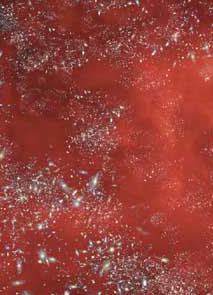Dark Energy
The papers below include the first observational case for the existence of dark energy (preceding the supernovae evidence by three years) and the introduction of the quintessence concept, the possibility that the dark energy density is time-varying and slowly decreasing.
J.P. Ostriker and P.J. Steinhardt
The observational case for low-density universe with a non-zero cosmological constant,
Nature 377 (1995) 600
First definitive empirical case for dark energy (three yrs prior to SNe data) and introduction of “cosmic concordance” (combining different evidence) in cosmology
P.J. Steinhardt
Cosmological challenges for the 21st century
in Critical Problems in Physics , ed. by V. L. Fitch and D. R. Marlow, (Princeton University Press, 1997)
Overview of open issues for the 21st century including an early discussion of the possibility of time-varying dark energy (the term “quintessence” had not be invented yet).
R. R. Caldwell, R. Dave, P.J. Steinhardt
Cosmological imprint of an energy component with general equation of state
Phys. Rev. Lett. 80, 1582
Paper that introduced the concept (and the term) “quintessence,” referring a time-varying form of dark energy
P.J. Steinhardt
A quintessential introduction to dark energy
Phil. Trans. R. Soc. Lond. A361 (2003) 2497
Review of case for quintessence dark energy circa 2003
D. Shlivko and P.J. Steinhardt
Optimal parameterizations for observational constraints on thawing dark energy
JCAP06 (2025) 054
Focusing on the class of thawing dark energy, we quantify and compare the precision with which nineteen generic and targeted parameterizations can capture the dynamics of physically motivated thawing quintessence theories. We find that a targeted parameterization derived from a Padé expansion of w(z) is the most reliable of these, producing accurate reconstructions of w(z), the expansion history H(z), and cosmological parameters such as H0 and Ωm for a broad range of microphysical theories.
D. Shlivko and P.J. Steinhardt
Assessing observational contraints on dark energy
Phys.Lett . B855 (2024) 138826
The current conventional approach for parameterizing observational constraints on time-varying dark energy give the misleading impression that null energy condition violation at large redshift is favored. This paper exposes the flaws in this parameterization and shows that quintessence models satisfying the null energy condition fit the observations equally well.
QUINTESSENTIAL DARK ENERGY AND STRING THEORY
N. Itzhaki, U. Peleg, P.J. Steinhardt
Instant folded strings, dark energy and a cyclic bouncing universe
arXiv:2508.09745 (2025)
We present a self-consistent, complete cyclic bouncing cosmology based on string theory components drawn and under perturbative control throughout. A central role is played by instant folded strings (IFSs) – fundamental strings much lighter than the string mass and extending far beyond the string length that violate the Null Energy Condition (NEC) and enable cosmological bounces and transient epochs of quintessence dark-energy domination.
A. Bedroya, H. Lee and P.J. Steinhardt
A species scale-driven breakdown of effective field theory in time-dependent string backgrounds
arXiv:2504.13260 (2025)
We present a novel way in which effective field theories (EFTs) (e.g., of quintessence) can break down in cosmological string backgrounds depending on the behavior of the quantum gravity cutoff in infinite distance limits, known as the species scale.
A. Bedroya, Q. Lu and P.J. Steinhardt
TCC in the interior of moduli space and its implications for the string landscape and cosmology
arXiv:2407.08793 (2024).
The case for the Transplanckian Censorship Conjecture (TCC) is strengthened, implying a new set of complex and highly nonlinear constraints across the entire string landscape which may make inflation impossible and restricts the ways dark energy can be incorporated in quantum gravity.
C. Deffayet, B.A. Ovrut and P.J. Steinhardt
Stable Vacua with Realistic Phenomenology and Cosmology in Heterotic M-theory Satisfying Swampland Conjectures
JHEP07, 288 (2024).
In this paper, we elucidate, in detail, the mathematical and computational methods required to utilize the protocol described in the paper listed below. These methods are then applied to a realistic heterotic M-theory model, the B−L MSSM, whose observable sector is consistent with all particle physics requirements. It is shown that the dilaton and universal moduli can be completely stabilized at values compatible with every phenomenological and mathematical constraint — as well as with ΛCDM cosmology. We also show that the heterotic M-theory vacua are consistent with all well-supported Swampland conjectures.
C. Deffayet, B.A. Ovrut and P.J. Steinhardt
Moduli axions, stabilizing moduli and the large field Swampland conjecture in Heterotic M-theory
Phys.Rev. D109, 12, 126004 (2024).
We compute the potential energy for the dilaton, complex structure and Kahler moduli and search of realistic vacua of heterotic M-theory compactified on Calabi-Yau threefolds. We present a protocol for deriving the potential that combines the non-perturbative complex structure, gaugino condensate and worldsheet instanton superpotentials in theories in which the hidden sector contains an anomalous U(1) structure group. We obtain explicit examples in which potential has a global minimum at negative or zero vacuum density or a metastable minimum with positive vacuum density.
A. Agrawal, G. Obied, P.J. Steinhardt and C. Vafa
On the Cosmological Implications of the String Swampland
Phys.Lett. B784, 271-6 (2018).
Although a cosmological constant may not be compatible with string theory if the Swampland picture is correct, quintessence may be compatible.
D. Wesley and P.J. Steinhardt
Dark Energy, Inflation and Extra Dimensions
Phys. Rev. D79 (2008) 104026
and
Exploring extra dimensions through observational tests of dark energy and varying Newton’s constant
Preprint (2010)
Two papers exploring why cosmic acceleration in the form of quintessence may be the most plausible form of dark energy in theories with extra spatial dimensions.
For more papers in cosmology, go here


